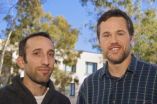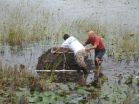(Press-News.org) COLUMBIA, Mo. -- The hand-held scanners, or tricorders, of the Star Trek movies and television series are one step closer to reality now that a University of Missouri engineering team has invented a compact source of X-rays and other forms of radiation. The radiation source, which is the size of a stick of gum, could be used to create inexpensive and portable X-ray scanners for use by doctors, as well as to fight terrorism and aid exploration on this planet and others.
"Currently, X-ray machines are huge and require tremendous amounts of electricity," said Scott Kovaleski, associate professor of electrical and computer engineering at MU. "In approximately three years, we could have a prototype hand-held X-ray scanner using our invention. The cell-phone-sized device could improve medial services in remote and impoverished regions and reduce health care expenses everywhere."
Kovaleski suggested other uses for the device. In dentists' offices, the tiny X-ray generators could be used to take images from the inside of the mouth shooting the rays outward, reducing radiation exposure to the rest of the patients' heads. At ports and border crossings, portable scanners could search cargoes for contraband, which would both reduce costs and improve security. Interplanetary probes, like the Curiosity rover, could be equipped with the compact sensors, which otherwise would require too much energy.
The accelerator developed by Kovaleski's team could be used to create other forms of radiation in addition to X-rays. For example, the invention could replace the radioactive materials, called radioisotopes, used in drilling for oil as well as other industrial and scientific operations. Kovaleski's invention could replace radioisotopes with a safer source of radiation that could be turned off in case of emergency.
"Our device is perfectly harmless until energized, and even then it causes relatively low exposures to radiation," said Kovaleski. "We have never really had the ability to design devices around a radioisotope with an on-off switch. The potential for innovation is very exciting."
The device uses a crystal to produce more than 100,000 volts of electricity from only 10 volts of electrical input with low power consumption. Having such a low need for power could allow the crystal to be fueled by batteries. The crystal, made from a material called lithium niobate, uses the piezoelectric effect to amplify the input voltage. Piezoelectricity is the phenomenon whereby certain materials produce an electric charge when the material is under stress.
###
Kovaleski's team published "Investigation of the Piezoelectric Effect as a Means to Generate X-Rays" in the journal IEEE Transaction on Plasma Science. Kovaleski is interim department chair of the Electrical & Computer Engineering in MU's Department of Engineering.
'Tricorder' invention could put medical diagnosis and terrorism prevention in the palm of the hand
The inexpensive device could improve health in the developing world and reduce mining risks
2013-01-09
ELSE PRESS RELEASES FROM THIS DATE:
'Universal' personality traits may not be universal after all
2013-01-09
(Santa Barbara, Calif.) –– For decades, consensus among psychologists has held that a group of five personality traits –– or slight variations of these five –– are a universal feature of human psychology. However, a study by anthropologists at UC Santa Barbara raises doubt about the veracity of that five-factor model (FFM) of personality structure as it relates to indigenous populations. Their findings appear in the current issue of the American Psychological Association's Journal of Personality and Social Psychology.
Studying the Tsimane, an isolated indigenous group ...
Counting the twists in a helical light beam
2013-01-09
Cambridge, Mass. - January 8, 2013 - At a time when communication networks are scrambling for ways to transmit more data over limited bandwidth, a type of twisted light wave is gaining new attention. Called an optical vortex or vortex beam, this complex beam resembles a corkscrew, with waves that rotate as they travel.
Now, applied physicists at the Harvard School of Engineering and Applied Sciences (SEAS) have created a new device that enables a conventional optical detector (which would normally only measure the light's intensity) to pick up on that rotation.
The ...
New marker of drug response may speed pace of lung cancer prevention trials
2013-01-09
Testing medicines to prevent lung cancer requires treating many thousands of high-risk individuals and then waiting 5, 10 or 15 years to discover which of them develop cancer and which, if any, experience survival benefit from the treatment. A University of Colorado Cancer Center study recently published in the journal Cancer Prevention Research proposes a possible waypoint on the way to benefit, which if validated, could dramatically reduce the number of patients needed and time required to test drugs for lung cancer prevention.
"Chemoprevention is an important approach ...
Battle of the sexes: Who wins (or loses) in ACL ruptures?
2013-01-09
ROSEMONT, Ill.—Female athletes are three times more likely to suffer from anterior cruciate ligament (ACL) ruptures, one of the most common knee injuries, compared to male athletes. The ACL is one of the four main ligaments within the knee that connect the femur (upper leg bone) to the tibia (lower leg bone). Recent research highlights the unique anatomical differences in the female knee that may contribute to higher injury rates, and should be taken into consideration during reconstructive surgery and sports training, according to a review article in the January 2013 issue ...
Chemists devise inexpensive, benchtop method for marking and selecting cells
2013-01-09
LA JOLLA, CA – January 8, 2013 - Chemists at The Scripps Research Institute (TSRI) have found an easier way to perform one of the most fundamental tasks in molecular biology. Their new method allows scientists to add a marker to certain cells, so that these cells may be easily located and/or selected out from a larger cell population.
The technique, which is described in a recent issue of the chemistry journal Angewandte Chemie International Edition, makes use of the tight binding of two proteins that are cheaply obtainable but are not found in human or other mammalian ...
Pythons, lionfish and now willow invade Florida's waterways
2013-01-09
Foreign invaders such as pythons and lionfish are not the only threats to Florida's natural habitat. The native Carolina Willow is also starting to strangle portions of the St. Johns River.
Biologists at the University of Central Florida recently completed a study that shows this slender tree once used by Native Americans for medicinal purposes, may be thriving because of water-management projects initiated in the 1950s. Canals were built to control runoff and provide water for agriculture. The unintended consequence -- stable water levels -- allowed Carolina Willow ...
Obesity drops among children enrolled in NY state WIC nutrition program
2013-01-09
New York children participating in a federal nutrition program had healthier eating behaviors and lower rates of obesity two years after improvements to the program were undertaken, according to a study published online today in Obesity, the official journal of the Obesity Society.
In 2009 all 50 states rolled out sweeping changes to the menu of foods available through the Special Supplemental Nutrition Program for Women, Infants, and Children, or WIC, which reaches nearly half of all infants born in the United States. New York was the first state in the nation to roll ...
Inside DayGlo: A video tour of the world's most colorful factory
2013-01-09
A new American Chemical Society (ACS) video provides a behind-the-scenes-look at the DayGlo Color Corp. factory, producer of the fluorescent paints that light up traffic cones, black light posters, hula-hoops and other products. The video, the latest episode of the award-winning Bytesize Science series from the world's largest scientific society, is at www.BytesizeScience.com.
Inside DayGlo opens with a brief history of the company, which has been designated as an ACS National Historic Chemical Landmark, and continues with an in-depth look inside its main production ...
Testing Einstein's E=mc2 in outer space
2013-01-09
With the first explosions of atomic bombs, the world became witness to one of the most important and consequential principles in physics: Energy and mass, fundamentally speaking, are the same thing and can, in fact, be converted into each other.
This was first demonstrated by Albert Einstein's Theory of Special Relativity and famously expressed in his iconic equation, E=mc2, where E stands for energy, m for mass and c for the speed of light (squared).
Although physicists have since validated Einstein's equation in countless experiments and calculations, and many technologies ...
Researchers try new approach for simulating supernovas
2013-01-09
VIDEO:
This is a computer simulation of one octant of a core collapse supernova, using SNSPH.
Click here for more information.
Two University of Texas at Arlington researchers want to bridge the gap between what is known about exploding stars and the remnants left behind thousands of years later. So they're trying something new – using SNSPH, a complex computer code developed at Los Alamos National Laboratory.
On Tuesday, Carola I. Ellinger, a post-doctoral researcher at ...
LAST 30 PRESS RELEASES:
Scalable and healable gradient textiles for multi‑scenario radiative cooling via bicomponent blow spinning
Research shows informed traders never let a good climate crisis go to waste
Intelligent XGBoost framework enhances asphalt pavement skid resistance assessment
Dual-function biomaterials for postoperative osteosarcoma: Tumor suppression and bone regeneration
New framework reveals where transport emissions concentrate in Singapore
NTP-enhanced lattice oxygen activation in Ce-Co catalysts for low-temperature soot combustion
Synergistic interface engineering in Cu-Zn-Ce catalysts for efficient CO2 hydrogenation to methanol
COVID-19 leaves a lasting mark on the human brain
Scientists use ultrasound to soften and treat cancer tumors without damaging healthy tissue
Community swimming program for Black youth boosts skills, sense of belonging, study finds
Specific depressive symptoms in midlife linked to increased dementia risk
An ‘illuminating’ design sheds light on cholesterol
Who is more likely to get long COVID?
Study showcases resilience and rapid growth of “living rocks”
Naval Research Lab diver earns Office of Naval Research 2025 Sailor of the Year
New Mayo-led study establishes practical definition for rapidly progressive dementia
Fossil fuel industry’s “climate false solutions” reinforce its power and aggravate environmental injustice
Researchers reveal bias in a widely used measure of algorithm performance
Alcohol causes cancer. A study from IOCB Prague confirms damage to DNA and shows how cells defend against it
Hidden viruses in wastewater treatment may shape public health risks, study finds
Unlock the power of nature: how biomass can transform climate mitigation
Biochar reshapes hidden soil microbes that capture carbon dioxide in farmland
Reducing saturated fat intake shows mortality benefit, but only in high-risk individuals
Manta rays create mobile ecosystems, study finds
Study: Mixed results in using lipoic acid to treat progressive multiple sclerosis
Norbert Holtkamp appointed director of Fermi National Accelerator Laboratory
New agentic AI platform accelerates advanced optics design
Biologists discover neurons use physical signals — not electricity — to stabilize communication
Researchers discover that a hormone can access the brain by hitchhiking
University of Oklahoma researcher awarded funding to pursue AI-powered material design
[Press-News.org] 'Tricorder' invention could put medical diagnosis and terrorism prevention in the palm of the handThe inexpensive device could improve health in the developing world and reduce mining risks


